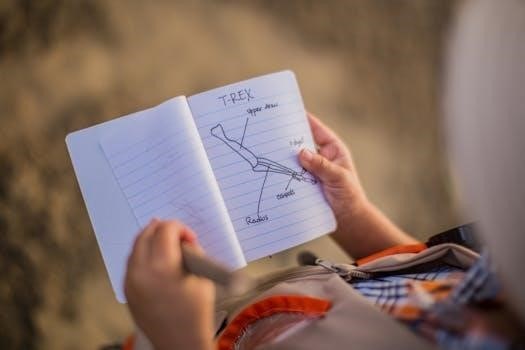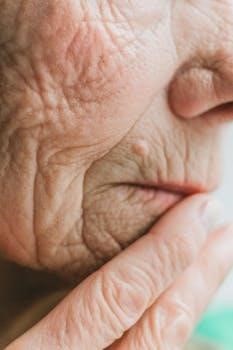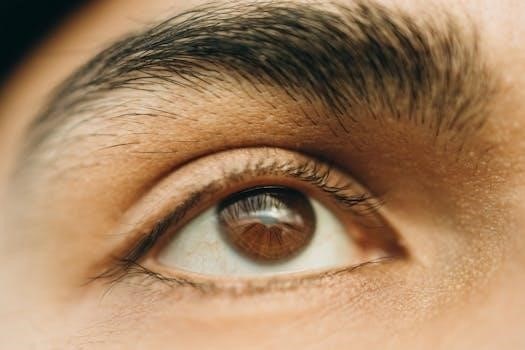
-
By:
- elizabeth
- No comment
essentials of human anatomy & physiology laboratory manual
Welcome! This laboratory manual provides hands-on experience; It is designed to accompany lectures and guide laboratory activities. This will help you to understand the complexities of the human body.
Overview of the Manual
This comprehensive manual is designed for introductory human anatomy and physiology courses. It offers a wide range of laboratory experiences for students in healthcare programs. Each exercise guides you towards understanding the structure and function of the human body. The manual combines clear instructions, safety tips, and tear-out worksheets. Over 50 lab videos, Practice Anatomy Lab 3.1 (PAL) and animations featured in selected pre-lab assignments and lab activities maximize student learning by reviewing key A&P concepts and lab procedures. Each lab video and media have been specially called out in the lab manual via a screenshot for easy reference. The lab manual uses artwork from Marieb/Hoehns Human Anatomy.
Purpose and Scope
The purpose of this laboratory manual is to provide a hands-on approach to learning human anatomy and physiology. It aims to reinforce concepts taught in lectures through practical application. The scope encompasses the language of anatomy, cells and tissues, and organ systems. It covers anatomical identification, dissection techniques, and physiological experiments. This manual helps students engage in lab activities and prepare effectively. By actively participating, students can apply theoretical knowledge to real-world scenarios. The content aligns with introductory college-level courses, ensuring relevance and depth. It serves as a practical guide for understanding the human body’s complexities through direct experience and observation.
Target Audience
This laboratory manual is primarily designed for students enrolled in introductory human anatomy and physiology courses at the college level. It caters to individuals pursuing careers in healthcare programs such as nursing, physical therapy, dental hygiene, and pharmacology. The manual is also suitable for students in pre-med programs and those seeking a foundational understanding of the human body. Its content and exercises are tailored to meet the needs of learners with varying levels of prior knowledge. It serves as a valuable resource for both traditional classroom settings and laboratory environments. It aims to enhance the learning experience for all students.

Key Topics Covered
This manual comprehensively covers the language of anatomy, exploring cells and tissues. It also delves into the intricate details of the organ systems that collectively comprise the human body and their functions.
Language of Anatomy
Mastering anatomical terminology is crucial for understanding the human body. This section introduces directional terms, regional terms, and anatomical planes. You will learn to accurately describe the location of body structures. Emphasis is placed on proper use of prefixes, suffixes, and root words. Learn about anatomical position and its importance in anatomical descriptions. This includes understanding the body’s organization from chemical to organismal levels. Exploration of body cavities and their respective membranes will also be covered. Practical exercises include identifying body regions and exploring surface anatomy. This provides a solid foundation for further study in anatomy and physiology.
Cells and Tissues
This section delves into the fundamental building blocks of the human body. First, you will explore cellular structures and their functions. Then, the different types of tissues will be examined. This includes epithelial, connective, muscle, and nervous tissues. Microscopic observation and identification of tissues are emphasized. Learn how to identify the characteristics of each tissue type under a microscope. This section also covers the functions of different types of tissues. Understand how tissues work together to form organs. The laboratory activities focus on preparing and staining tissue samples. Further, you’ll learn to identify tissues based on their microscopic features.
Organ Systems
This section explores the major organ systems of the human body. This includes the integumentary, skeletal, muscular, nervous, endocrine, cardiovascular, lymphatic, respiratory, digestive, urinary, and reproductive systems. You will study the structure and function of each organ system. Understand how each system contributes to overall homeostasis. Learn to identify the major organs within each system through dissection and models. The laboratory exercises include anatomical identification of organs. This section also includes physiological experiments to demonstrate system functions. Dissection activities will focus on observing and identifying the components of different organ systems. Students will also learn about common diseases. Learn about how diseases affect organ systems.

Laboratory Exercises
The manual features a wide variety of experiments for students concentrating in healthcare programs. Each exercise leads you toward an understanding of the structure and function of the human body.
Dissection Techniques
This section offers a step-by-step guide to dissection, ensuring students gain hands-on practice. This is needed to truly understand anatomical structures and their functions. The manual includes clear instructions. Safety tips are also included to make the dissection process effective and safe. Dissection exercises include both cat and fetal pig specimens. These provide a comprehensive understanding of mammalian anatomy. Detailed illustrations and photographs accompany each dissection. This makes it easier to identify structures. Emphasis is placed on proper handling of specimens and ethical considerations. Dissection allows for a three-dimensional understanding. It complements textbook learning and enhances spatial reasoning skills. Students will develop proficiency in using dissection tools. This will enable them to explore anatomical relationships effectively.
Anatomical Identification
This section focuses on developing skills in identifying anatomical structures. It utilizes various resources like model photos and detailed diagrams. This ensures students can confidently recognize different parts of the human body. Exercises involve labeling anatomical models, both physical and virtual. Practice Anatomy Lab (PAL) is integrated. It provides interactive 3D models for enhanced learning. Over 100 specially-commissioned anatomical model photos are included. These aid in accurate identification. The manual covers a wide range of structures, from cells and tissues to organ systems. Quizzes and practical exams are incorporated. This assesses students’ ability to identify structures under time constraints. Emphasis is on understanding the relationships between structures. This enhances comprehension of overall anatomy. This skill is critical for healthcare programs.
Physiological Experiments
This section provides hands-on physiological experiments. These experiments allow students to explore the functions of the human body. Experiments cover various systems, including cardiovascular, respiratory, and nervous systems. BIOPAC exercises are integrated. These offer advanced data acquisition and analysis. Simulated lab experiences in an interactive 3D environment are included. These enhance understanding of complex physiological processes. Students learn to collect and interpret physiological data. They also analyze results using appropriate statistical methods. Each experiment includes pre-lab preparation and post-lab analysis. This reinforces learning and critical thinking skills. Safety protocols are emphasized to ensure a safe laboratory environment. These experiments are designed to complement lecture material. They provide a practical understanding of physiological principles. Real-world applications are highlighted. This demonstrates the relevance of physiological concepts to healthcare. The lab manual uses artwork from Marieb/Hoehns Human Anatomy.

Features and Resources
This manual includes pre-lab activities for preparation. Post-lab activities reinforce learning. Online resources like eLabs and videos enhance the learning experience. These features support comprehensive understanding of anatomy and physiology.
Pre-Lab Activities
To ensure a productive and educational laboratory experience, pre-lab activities are essential. These activities prepare students for the hands-on work they will be performing in the lab. Each pre-lab exercise is designed to introduce key concepts, terminology, and procedures that will be encountered during the lab session. This may include reading assigned sections from the textbook, watching relevant videos, or completing online quizzes. Pre-lab assignments maximize student learning by reviewing A&P concepts and lab procedures. By completing these activities before attending the lab, students will be better equipped to engage with the material and make the most of their time in the lab. Pre-lab videos, vocabulary activities, review questions, and art labeling activities can all be part of pre-lab preparation.
Post-Lab Activities
Post-lab activities are designed to reinforce learning and assess comprehension. These activities provide opportunities to consolidate knowledge gained during the lab session. These may include completing lab reports, answering review questions, or participating in group discussions. Post-lab assignments encourage critical thinking. They help students apply what they learned in the lab to real-world scenarios. These activities also provide feedback, identifying areas where further study may be needed. Reviewing vocabulary and understanding the practical applications of the lab exercises are key parts of the post-lab experience. Completing worksheets and reflecting on experimental results enhance understanding. Post-lab assessments evaluate the student’s grasp of the material covered. This ensures a thorough learning experience.
Online Resources (eLabs, Videos)
Enhance your learning experience with our extensive suite of online resources. These include interactive eLabs and detailed video demonstrations. eLabs offer simulated lab experiences, allowing exploration in a 3-D environment. Practice anatomical identification and dissection techniques virtually. Our video library features over 50 lab videos. These videos review key A&P concepts and lab procedures. Access Practice Anatomy Lab (PAL 3.1) with customizable flashcards. Focus Figure Mini-Animations are also available. Pre-lab videos prepare you for hands-on activities. Building Vocabulary Coaching Activities reinforce terminology. Online resources are accessible anytime, anywhere, promoting flexible learning. Maximize your understanding with these engaging and comprehensive digital tools. These will support your success in the A&P lab.

Editions and Customization
Tailor your learning experience with varied editions. Options include main, cat, and pig versions. Customization options allow adaptation; Mastering A&P integration provides tools. This will maximize student learning by reviewing key concepts.
Available Editions (Main, Cat, Pig)
The laboratory manual is available in multiple editions to suit various course needs and preferences. The Main Edition offers a comprehensive overview of human anatomy and physiology, suitable for general introductory courses. For programs incorporating dissection, the Cat Edition includes detailed cat dissection exercises, providing hands-on experience with mammalian anatomy. Similarly, the Pig Edition features fetal pig dissection exercises, offering another valuable comparative anatomy experience. These specialized editions complement the core content with species-specific dissections, enhancing understanding of anatomical structures and their functions. Selecting the appropriate edition ensures alignment with curriculum requirements and learning objectives. Choose based on dissection needs.
Customization Options
To better meet the specific needs of different courses and institutions, the laboratory manual offers several customization options. Instructors can select specific exercises and activities to align with their curriculum’s focus and learning objectives. Additional content, such as institution-specific protocols or supplemental readings, can be integrated to enhance the manual’s relevance. Custom cover designs and branding options are also available, allowing institutions to create a unique and personalized resource for their students. Furthermore, digital versions of the manual can be tailored with interactive elements and multimedia resources, providing an engaging and dynamic learning experience. These customization options ensure the manual is perfectly suited to each course.
Mastering A&P Integration
This laboratory manual seamlessly integrates with Mastering A&P, offering a comprehensive learning experience. Recommended Mastering A&P activities, aligned with each lab exercise, enhance student preparation and understanding. Pre-lab videos, Building Vocabulary Coaching Activities, and exercise review questions provide a structured approach to learning. Art labeling activities and mobile-ready Practice Anatomy Lab (PAL 3.1) with customizable flashcards further reinforce key concepts. Interactive Physiology 2.0 tutorials and Focus Figure Mini-Animations offer dynamic visualizations. This integration ensures students engage with the material in multiple ways, maximizing their learning potential. Mastering A&P’s assessment tools provide valuable insights into student progress. Instructors can track performance and tailor instruction accordingly.